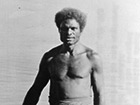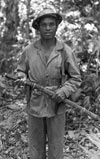Sir Jacob Charles Vouza
Solomon Island Scout
Background
Jacob Charles Vouza was a Solomon Islander born around 1900 in Tasimboko on Guadalcanal. He was educated at the South Seas Evangelical Mission School. In 1916, he joined the Solomon Island Police Force (SIPF) as a native police officer (constabulary). By 1938, Vouza had achieved the rank of Sergent in the police force on Malatia Island and first met Martin Clemens, who he would later serve with as a coastwatcher and scout during World War II. During 1941, Vouza retired from the Police.
Wartime History
On May 6, 1942 Vouza returned to Guadalcanal.
In early July 1942 the after Japanese forces landed on Guadalcanal, Vouza resumed active police service and remained loyal to the British administration.
During early August 1942, Vouza walked into a Japanese Army, 28th Infantry Regiment "Ichiki Regiment" bivouac and was captured and accused of being a spy. When he was searched, they found a small U.S. flag under his lap-lap (a cloth wrapped around the waist). Afterwards, he was tied to a tree and was questioned but said nothing. Likely, he was interrogated by either Kiichi Oshima (who spoke Japanese) or Reiichi Kinoshita. Frustrated, Japanese soldiers cut him with their bayonets wounding him. Despite this torture, Vouza did not say a word and by dusk fell unconscious from the wounds. Later, Vouza claimed his interrogator or torturer was Terushige Ishimoto who spoke English and conscripted local laborers, but he was elsewhere at the time.
Amazingly, he managed chew through the ropes holding his hands and escape but weaked had to crew roughly three miles before reaching the U.S. perimeter at Tenaru (Ilu River). The first sentry he encountered was U.S. Marine Wilbur Bewley who let him enter the line. Afterwards, he was given first aid for his wounds and a transfusion of many pints of blood. When debriefed, he provided information to the Marines about his home village of Tasimboko that was used to plan the raid led by Col Merritt A. Edson planned for early September 1942.
After twelve days recovering from his wounds, Vouza became the "chief scout" for the Marines and helped guide the 2nd Marine Raider Battalion on their raid against Tasimboko on September 8, 1942. He also participated in the rest of the Guadalcanal campaign. In December 1942, Jacob Vouza was photographed at Henderson Field wearing Marine uniform with Sergeant Major rank insignia holding the severed head of a Japanese soldier [warning graphic photograph]. with a caption stating the head was a revenge killing for his earlier capture and torture. More likely, the head was from a soldier killed at The Gifu and posed for propaganda purposes.
Awards
For his World War II service, Vouza earned several U.S. awards including the Silver Star for refusing to give information under Japanese torture, awarded by General Alexander A. Vandegrift. He also earned the Legion of Merit for his service to the 2nd Marine Raiders. He earned the British George Medal for "gallant conduct and exceptional devotion to duty". Later, he also was awarded the Police Long Service Medal. In 1957 he was awarded the Order of the British Empire (OBE) for his faithful service.
Postwar
After World War II, Vouza renamed his village "California" in honor of the American friends he made during the war. In 1949 Vouza became a district headman and President of the Guadalcanal Council from 1952-58. Between 1950–1960 he was on the Solomons protectorate advisory board.
In 1962, he sent a message to the 1st Marine Division Association: "Tell them I love them all. Me old man now, and me no look good no more. But me never forget." During 1967, when visited by U.S. Marines, Vouza expressed interest in visiting the United States. In 1968, he visited the United Sates with Coastwatcher Martin Clemens as a guest of the 1st Marine Division. In 1979, knighted by Queen Elizabeth, becoming Sir Jacob Charles Vouza.
Jacob Vouza Scholarship
After his visit to the United States, Marine Corps veterans started the "Jacob Vouza scholarship" to provide educational opportunities to students in the Solomon Islands and in appreciation for his loyalty to the Allied cause and aid to the United States.
Memorials
On March 15, 1984 at age 84, Vouza passed away and was buried in his Marine uniform with all
his medals in California village on Guadalcanal. His grave includes a concrete slab with a marker that reads: "In loving memory of our beloved father late Sir Jacob Charles Vouza died on 15 March 1984 at the age of 84". A rectangular marker overlooking the grave has a brass plaque reads:
"We dedicate to Sergeant Major Jacob Vouza and his Solomon Island scouts for supreme intrepidity and valour in the face of the enemy during the struggle for Guadalcanal 1942-1943 presented by U.S. Marine Raiders Association".
In Honiara at the Rove Police Barracks is the Jacob Vouza memorial with a statue of Vouza wearing a lap-lap holding a machete. The memorial has three bronze plaques.
References
USMC 1st Marine Division D-2 (Intelligence) "Ishimoto [sic] had bayoneted a native chief [Jacob Vouza] and left him for dead. The chief was not dead and made his way back to the Marine lines, from where he was taken to the hospital and cared for. This chief recovered and became a very valuable scout. He furnished very accurate information for the 1st Raider Battalion prior to the raid on Tasimboko. After repeated questions it was learned that Ishimoto was not in this vicinity but that a Jap officer by the name of Tasimoto [unknown] was there. The natives claimed that Tasimoto was sick with malaria."
Marines in World War II The Guadalcanal Campaign Chapter IV: Establishment of the Perimeter and Battle of the Tenaru pages 62, 67 footnotes 20, 47
Leatherneck Magazine "Sir Jacob Vouza" by Tom Bartett originally published May 1944, updated via Wayback Machine August 11, 2012
When the Sun stood still: The Untold Story of Sir Jacob Vouza and the Guadalcanal Campaign (1992) by Don Richter
The Mysterious Mr. Moto on Guadalcanal (2007) by Stan Jersey
Watriama and Co: Further Pacific Islands Portraits (2013) by Hugh Laracy page 229, 243, 244, 245, 251, 256
Marine Raider Association - Projects: Vouza Education Initiative
"Since 1971, the Raiders have funded a scholarship program for native-born children of the Solomon Islands to attend a boarding school located on Guadalcanal. This program is called the Vouza Scholarship Initiative"
Thanks to Martin Clemens, John Innes and Peter Flahavin and Solomon Scouts & Coastwatchers Trust (SSCT) for additional information
|









